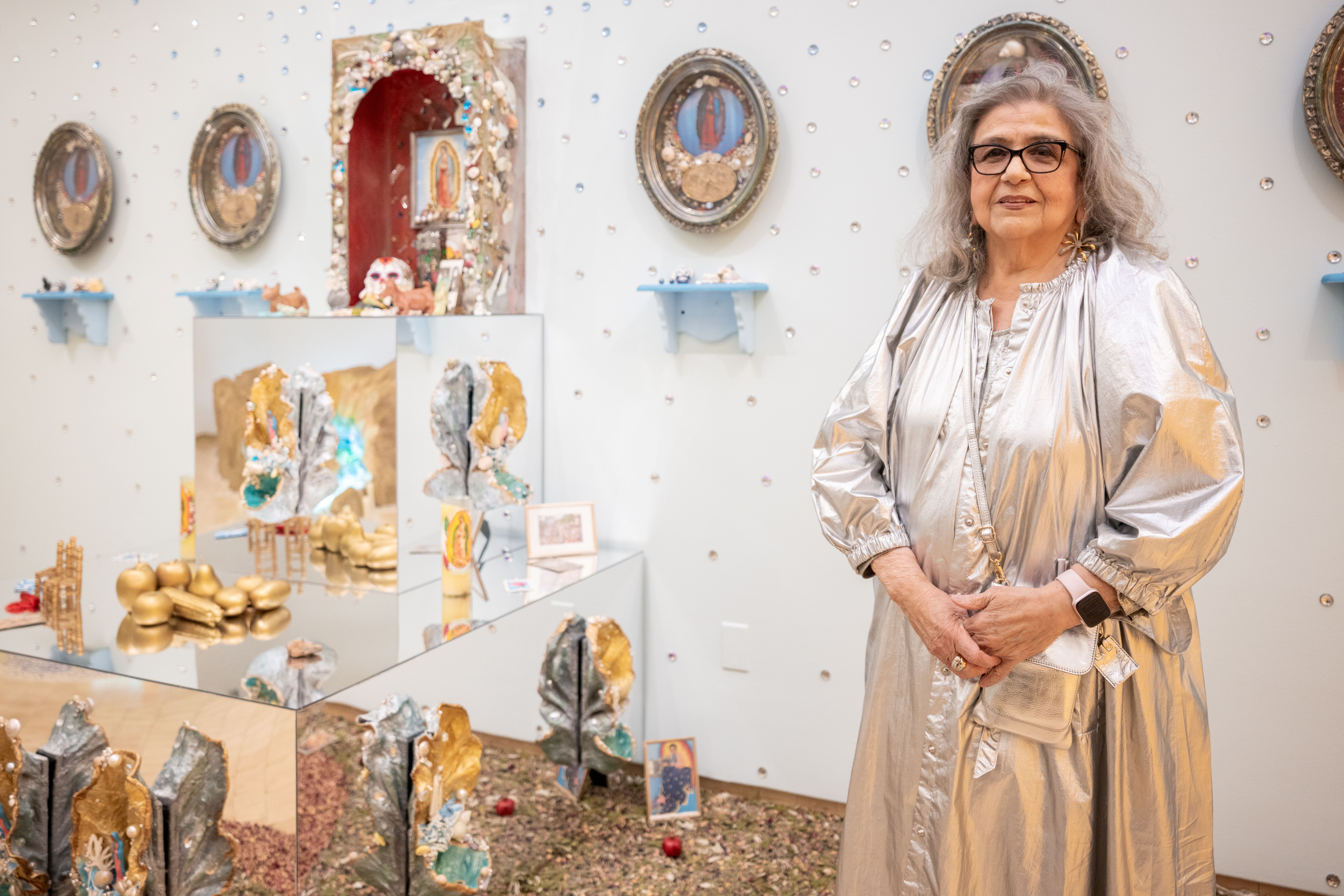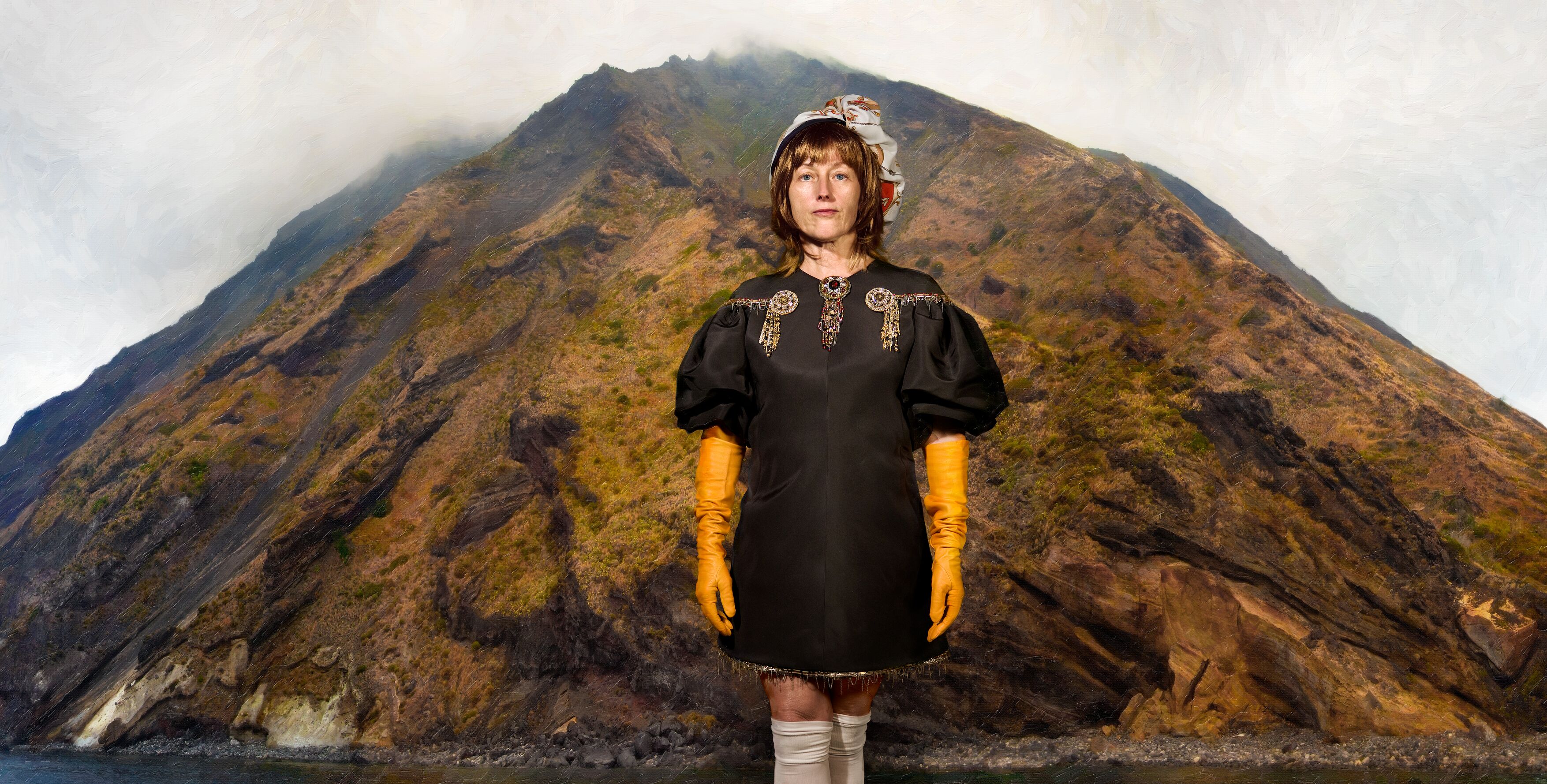‘Very few museums were interested in my work until recently’: Amalia Mesa-Bains on her first-ever retrospective
‘Amalia Mesa-Bains: Archaeology of Memory’ is a long-overdue exhibition at El Museo del Barrio in New York celebrating five decades of the trailblazing Chicanx artist

‘Amalia Mesa-Bains: Archaeology of Memory’ marks a significant milestone as the first retrospective dedicated to the pioneering Chicanx installation artist, curator and theorist Amalia Mesa-Bains. Organised by the Berkeley Art Museum and Pacific Film Archive and hosted at El Museo del Barrio in New York, the exhibition provides a rare and long-overdue opportunity to delve into three decades of the artist’s genre-defying artworks, including her emblematic large-scale altar installations, prints, books and codices – many seen together for the first time.
Amalia Mesa-Bains recounts her spellbinding artistic journey

Portrait of Amalia Mesa-Bains (2024)
Despite delving into intersectional feminist themes, environmentally-centred spirituality and cultural diversity to challenge the racist and gendered erasures of colonial repression for nearly half a century, Mesa-Bains confesses she never expected to have a retrospective. ‘Very few mainstream museums in this country were interested in my work until quite recently,’ the artist shares with Wallpaper*.

Amalia Mesa-Bains: An Ofrenda for Dolores del Rio (1984/1991)

Amalia Mesa-Bains, Venus Envy Chapter I: First Holy Communion, Moments Before the End (1993)
Born in California in 1943 to a Mexican immigrant family, Mesa-Bains grew up in a largely undocumented community. ‘I always knew I was born in the States but was raised as a Mexican, which seemed confusing. Turning to art at a young age and encountering the Chicano movement offered me a real sense of belonging,’ she reflects. Beginning her artistic exploration within the intimate sphere of family and community, alongside fellow Latinos and artists of colour, led Mesa-Bains to research Mexican ancestral traditions during the mid-1970s.

Amalia Mesa-Bains, Curando in Venus Envy Chapter IV: The Road to Paris and Its Aftermath, The Curandera’s Botanica (2008/2023)

Installation view of Amalia Mesa-Bains, Museum of Fatima (1995). In 25th Anniversary Exhibition: Part III Reaffirming Spirituality (1985)
Mesa-Bains’ extensive exploration culminates in her large-scale reinterpretations of home altars and ofrendas (offerings to the deceased), which serve as alternative sacred spaces for Mexican and Latino communities diverging from traditional church settings and a way for women to extend spiritual power in the home – as seen in The Library of Sor Juana Inés de la Cruz (1994/2021). Mesa-Bains emphasises how both forms of expression also contribute to the cultural reclamation of Chicanx communities: ‘The recognition of the dead as an ongoing part of one’s life and the celebration of life as a joyous tradition offers an alternative to the Anglo-American approach to mourning and death.’

Installation view of Amalia Mesa-Bains, Venus Envy Chapter I: First Holy Communion, Moments Before the End (1993/2022). San Francisco Museum of Modern Art

Installation view of Amalia Mesa-Bains, The Library of Sor Juana Inés de la Cruz from Venus Envy Chapter II: The Harem and Other Enclosures (1994/2021). Williams College Museum of Art
In pieces like Queen of the Waters, Mother of the Land of the Dead (1992), which pays homage to the Virgin of Guadalupe and Tonantzin and is showcased in the exhibition, Mesa-Bains draws inspiration from women across personal, historical and religious realms, portraying them as embodiments of spiritual and intellectual authority. Reflecting on this, she remarks, ‘Women of colour need to work together to liberate ourselves. Class and race have always intersected my life: I watched my mother clean houses of naval families and learned to enter their homes by side or back doors.’

Installation view of Amalia Mesa-Bains, Queen of the Waters, Mother of the Land of the Dead: Homenaje a Tonatzin/Guadalupe (1992)

Installation view of Amalia Mesa-Bains, Museum of Fatima (1995). In 25th Anniversary Exhibition: Part III Reaffirming Spirituality (1985)
The 40 artworks featured in ‘Amalia Mesa-Bains: Archaeology of Memory’ offer a comprehensive overview of the artist’s evolution, showcasing her enduring commitment to social justice issues. The exhibition’s title nods to Mesa-Bains’ conviction that memory is a powerful tool for challenging the legacies of colonisation. Mirrors strategically placed throughout the exhibition, such as in Circle of Ancestors (1995), dissolve the divide between the viewer and the artwork, symbolising luminosity, reflection, and identity. Mesa-Bains notes, ‘Many visitors share images of themselves reflected in the mirrors, sparking discussions about the complexities of their own existence.’

Installation view of Amalia Mesa-Bains, Circle of Ancestors (1995). El Museo del Barrio, New York
‘Archaeology of Memory’ represents the first occasion where the Mesa-Bains’ Venus Envy (1993) series is showcased entirely, consolidating four chapters previously exhibited across various institutional venues. This body of work stands as a bold reinterpretation of the Freudian notion of Penis Envy (1908), reclaiming agency over women’s psychosexual development – an idea Mesa-Bains encountered during her training as a psychologist. Intriguingly, the genesis of Venus Envy coincided with Mesa-Bains’ battle with heart and lung disease, a health crisis that starkly confronted her mortality. This experience prompted her to refocus her artistic endeavours towards a more introspective exploration of themes surrounding the body, spirit and culture, realising the urgency of sharing her own narrative.
Receive our daily digest of inspiration, escapism and design stories from around the world direct to your inbox.

Amalia Mesa-Bains, Queen of the Waters, Mother of the Land of the Dead: Homenaje a Tonatzin/Guadalupe (1992)

Amalia Mesa-Bains, Venus Envy Chapter I: First Holy Communion, Moments Before the End (1993)
At 80 years old, Mesa-Bains has recently found herself invigorated by the landscape surrounding her home and the parallels between ageing and nature’s cyclical rhythms. The artist reveals her recent musings on the concept of a tree library, a collection of books, plant and tree specimens, and archival prints concerning healing practices. ‘I feel as though this world of natural growth is an extension of my lifelong concern with healing.’ The artist finishes the interview by reciting a line by philosopher Nezahualcoyotl: ‘We are like the spring grass / We bud, blossom, dry up and blow away / We were never meant to be on this earth forever.’

Installation view of Amalia Mesa-Bains, What the River Gave to Me (2002). El Museo del Barrio, New York
‘Amalia Mesa-Bains: Archaeology of Memory’ is on view at El Museo del Barrio in New York until 11 August 2024, elmuseo.org
Sofia de la Cruz is the Travel Editor at Wallpaper*. A self-declared flâneuse, she feels most inspired when taking the role of a cultural observer – chronicling the essence of cities and remote corners through their nuances, rituals, and people. Her work lives at the intersection of art, design, and culture, often shaped by conversations with the photographers who capture these worlds through their lens.
-
 Wallpaper* checks in at Jnane Rumi: clarity, reflection and connection
Wallpaper* checks in at Jnane Rumi: clarity, reflection and connectionIn the quiet tranquillity of Marrakech’s Palmeraie, Jnane Rumi evokes a rich and colourful tapestry of Moroccan art, craftsmanship and design
-
 Cindy Sherman in Menorca: ‘She's decades ahead of social media and the construction of identity for the camera’
Cindy Sherman in Menorca: ‘She's decades ahead of social media and the construction of identity for the camera’‘Cindy Sherman: The Women’, its title a nod to an image-conscious 1930s Broadway hit, takes the American artist's carefully constructed, highly performative works to Hauser & Wirth Menorca
-
 A Rancho Mirage home is in tune with its location and its architect-owners' passions
A Rancho Mirage home is in tune with its location and its architect-owners' passionsArchitect Steven Harris and his collaborator and husband, designer Lucien Rees Roberts have built a home in Rancho Mirage, surrounded by some of America’s most iconic mid-century modern works; they invited us on a tour
-
 ‘Her pictures looked like pictures everybody knew were the truth’: Diane Arbus at the Armory
‘Her pictures looked like pictures everybody knew were the truth’: Diane Arbus at the ArmoryMatthieu Humery curates more than 400 of Arbus’ photographs at New York’s Park Avenue Armory – every picture she was known to have printed
-
 Out of office: the Wallpaper* editors’ picks of the week
Out of office: the Wallpaper* editors’ picks of the weekIt was a jam-packed week for the Wallpaper* staff, entailing furniture, tech and music launches and lots of good food – from afternoon tea to omakase
-
 Out of office: what the Wallpaper* editors have been up to this week
Out of office: what the Wallpaper* editors have been up to this weekThis week saw the Wallpaper* team jet-setting to Jordan and New York; those of us left in London had to make do with being transported via the power of music at rooftop bars, live sets and hologram performances
-
 New book celebrates 100 years of New York City landmarks where LGBTQ+ history took place
New book celebrates 100 years of New York City landmarks where LGBTQ+ history took placeMarc Zinaman’s ‘Queer Happened Here: 100 Years of NYC’s Landmark LGBTQ+ Places’ is a vital tribute to queer culture
-
 Ai Weiwei’s new public installation is coming soon to Four Freedoms State Park
Ai Weiwei’s new public installation is coming soon to Four Freedoms State Park‘Camouflage’ by Ai Weiwei will launch the inaugural Art X Freedom project in September 2025, a new programme to investigate social justice and freedom
-
 Leonard Baby's paintings reflect on his fundamentalist upbringing, a decade after he left the church
Leonard Baby's paintings reflect on his fundamentalist upbringing, a decade after he left the churchThe American artist considers depression and the suppressed queerness of his childhood in a series of intensely personal paintings, on show at Half Gallery, New York
-
 This rainbow-coloured flower show was inspired by Luis Barragán's architecture
This rainbow-coloured flower show was inspired by Luis Barragán's architectureModernism shows off its flowery side at the New York Botanical Garden's annual orchid show.
-
 ‘Psychedelic art palace’ Meow Wolf is coming to New York
‘Psychedelic art palace’ Meow Wolf is coming to New YorkThe ultimate immersive exhibition, which combines art and theatre in its surreal shows, is opening a seventh outpost in The Seaport neighbourhood